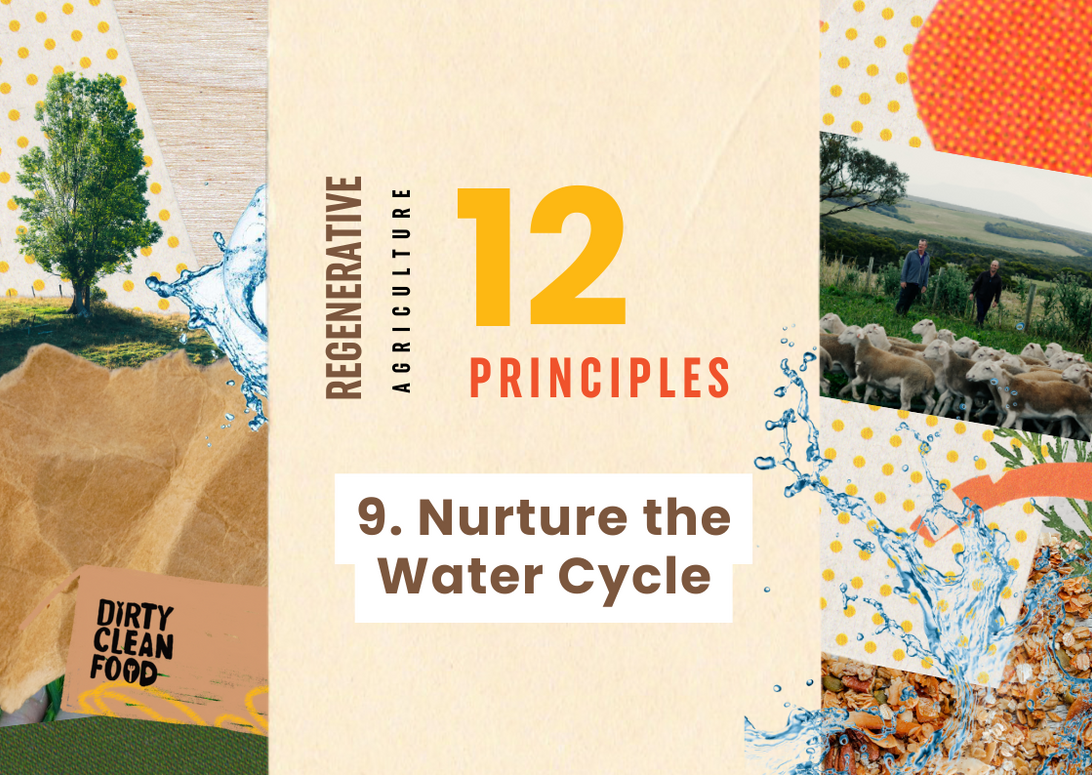
Regen Ag #9- Nurture the Water Cycle
|
Time to read 4 min
|
Time to read 4 min
Welcome to our 12 Principles of Regenerative Agriculture series- where we define "regen ag" and show you how regenerative farming changes the planet, the system, and our food.
Regenerative agriculture is a holistic approach to farming that seeks to restore and enhance the health and ecological function of the land, rather than deplete it. One of our 12 core Regenerative Agriculture principles, Nurturing the Water Cycle recognizes the vital role water plays in sustaining life and fostering biodiversity. In this blog post, we'll delve into the importance of this principle and explore how it can be implemented to create resilient and thriving agricultural systems.
Water is the lifeblood of our planet, essential for the growth of crops, the health of ecosystems, and the well-being of communities. However, conventional agricultural practices have often led to the degradation of water resources through soil erosion, pollution, salinity, and the depletion of aquifers. In contrast, regenerative agriculture aims to work in harmony with nature, harnessing the power of the water cycle to build soil fertility, mitigate climate change, and promote water conservation.
One of the key strategies of nurturing the water cycle in regenerative agriculture is through soil health management. Healthy soils act as a sponge, absorbing and retaining water, thus reducing runoff and minimizing erosion. Up to 80% of the rain that hits bare soil in Australia actually evaporates! This is greatly reduced if the rain falls on living plants or plant residue. Practices such as minimal tillage, cover cropping, retaining crop and pasture residue or creating a mulch layer help to improve soil structure, increase organic matter content, and enhance water infiltration rates. By building healthy soils, farmers can better withstand droughts, floods, and other extreme weather events, while also increasing the length of their growing season.
Another important aspect of nurturing the water cycle is restoring natural hydrological processes in the landscape. This involves re-establishing riparian buffers, wetlands, and other water-holding features that help to regulate the flow of water, reduce erosion, and recharge groundwater supplies. By restoring these ecosystems, farmers can create habitat for wildlife, improve water quality, and enhance the resilience of their farms to climate change.
Furthermore, regenerative agriculture emphasizes the importance of capturing and storing water on-farm through rainwater harvesting and retention ponds. By capturing rainwater where it falls and storing it for later use, farmers can reduce their reliance on external water sources and buffer against water scarcity during dry periods. This not only benefits the farm operation but also contributes to the watershed's overall health by reducing runoff and erosion.
In addition to on-farm water management strategies, our approach recognizes the interconnectedness of landscapes and the need for collective action at the watershed level. By collaborating with neighbouring landowners, conservation organisations, and government agencies, farmers can implement landscape-scale water conservation projects that benefit the entire community. This may include watershed restoration initiatives, land-use planning, and policy advocacy aimed at protecting and preserving water resources for future generations.
We, alongside our farmers, work with their local catchment councils and Natural Resource Management (NRM) groups, collaborating in relevant projects across the wider landscape.
Steve Ford has been using all the above practices to ensure he has a good mulch layer of retained crop stubble or residue, that helps to retain moisture in the soil, and improve infiltration rates in the rain that falls on the surface of the paddock.
Blythe and Gregg have been using their flood irrigation strategically to help them get an early germination this summer and autumn, which is helping them to bridge the autumn feed gap. We have had such a dry spring, summer and autumn that dry feed is running low, so Blythe and Gregg have seeded a multi species summer mix earlier this year, and a winter pasture mix, and used their flood irrigation to get it growing before the first rains have arrived. The early germination has allowed them to grow pasture to wean their calves onto, ensuring the calves keep growing strong and healthy.
Warren Pensini has been focusing on this approach with his Mulloon Rehydration Farm Plan, which provided the structure and defined the areas where he has planted trees as part of the Dirty Clean Food Regenerative Farmer Tree Project. Trees have been planted below contour lines, which is moving excess water along the contour, and helping to keep water high in the landscape, slowing it down and helping it to infiltrate into the soil.
Jamie Anderson has installed a series of interceptor banks on his farm, that catch subsurface water after it has filtered through the soil profile. This is an alternative to catching surface runoff, which can cause erosion as it flows over the surface of the soil, and deposits topsoil and animal manure into the dams via surface runoff.
These interceptor banks work where there is sandy topsoil, with a clay subsoil layer. Rain that falls on the soil's surface is filtered down through the sand layer and then runs along the top of the clay layer. The banks are cut by an excavator at 1200mm deep in the soil profile, and only capture the excess water not being used higher up in the soil profile. This water is then channeled into the dam, providing filtered drinking water for their sheep.
Nurturing the water cycle is a fundamental principle of regenerative agriculture that holds the key to building resilient and sustainable food systems. By focusing on soil health, restoring natural hydrological processes, and capturing and storing water on-farm, farmers can enhance the health of their land, mitigate climate change, and promote water conservation. Through collective action and a commitment to working in harmony with nature, we can create a future where water is abundant, clean, and shared equitably among all living beings.
‘Regenerative agriculture is an ecological approach to farming that allows landscapes to renew themselves.’








